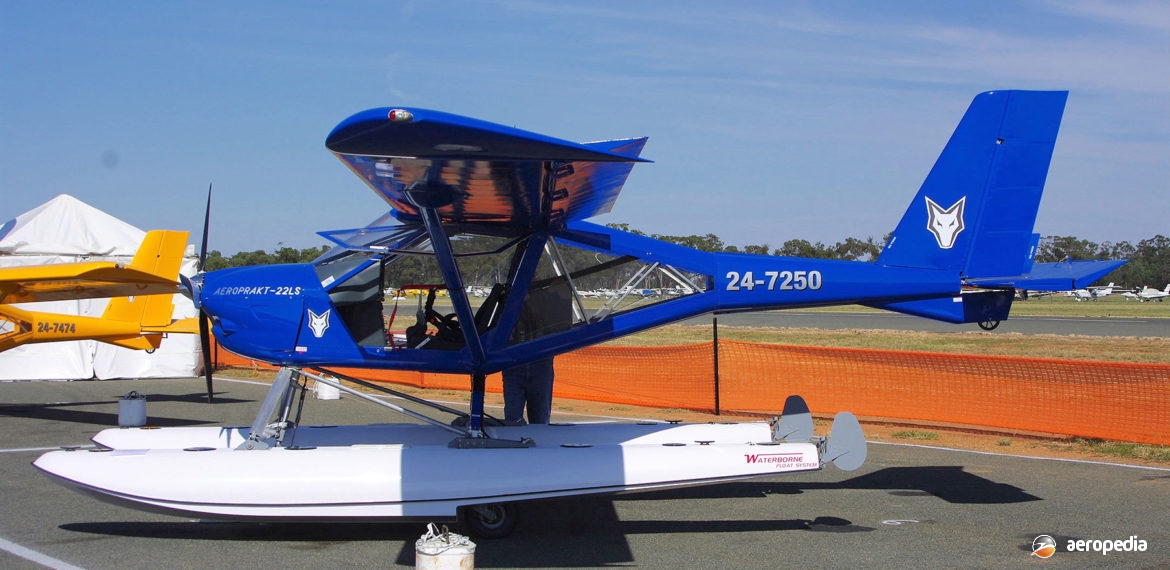Photograph:
Aeroprakt A-22LS Foxbat floatplane (c/n 24-7250) at Temora, NSW (David C Eyre)
Country of origin:
The Ukraine
Description:
Two-seat light touring and training monoplane
Power Plant:
One 75 kw (100 hp) Rotax 912ULS four-cylinder, four-stroke, liquid-and-air-cooled engine
Specifications:
- Wingspan: 10 m (32 ft 8 in)
- Length: 6.3 m (20 ft 6 in)
- Height: 2.4 m (7 ft 8 in)
- Wing area: 13.7 m² (147.4 sq ft)
- Max speed: 161 km/h (100 mph)
- Cruising speed at 75% power: 137 km/h (85 mph)
- Stalling speed full flap: 53 km/h (33 mph)
- Service ceiling: 4,572 m (15,000 ft)
- Range in still air: 800 km (497 miles)
- Empty weight: 264 kg (582 lb)
- Loaded weight: 544 kg (1,199 lb)
History:
The A-22 Foxbat was a quick-build aircraft kit produced in the Ukraine aimed at the ultralight market but which could also be registered in the general aviation category. By the end of 2001 more than 50 kits had been built and sold around the world. The type has been certified in both the United Kingdom under BCAR Section S, and in Germany under BFU-95 standards.
The type was first conceived in 1995 from the A-20, being designed by Yuri Yakovlev, an engineer with the Antonov Design Bureau, who founded the Antonov Amateur-design Flying Club, as an easy-to-fly two-seat high-wing light aeroplane with a comfortable cockpit, good visibility and good all-round performance. The prototype first flew in 1996 and the first production machine carried out testing in the United Arab Emirates.
The aircraft was powered by the Rotax 912ULS four-cylinder air-and-liquid cooled engine driving a three-blade ground-adjustable propeller, but a two-blade Tonini unit was also available. It could operate from a 200 m (656 ft) ultralight strip and had good STOL capability. Construction was mainly of aluminium, the riveted monocoque airframe being of anodised aluminium with part fabric covered wings and control surfaces. The bubble doors were removable and the cockpit was 128 cm (50 inches) wide. Fuel to a total of 85 litres (18.7 Imp gals) was carried in dual wing tanks. The type was marketed in the United States as the A-22 Valor.
The first of the type seen in this region VH-VPH (c/n 030/PFA317-13786) arrived in mid 2002 as a demonstrator for the importer, Fox Aircraft of the Gold Coast, Queensland. First of the type registered in New Zealand was ZK-PGC (c/n 079).
Following the introduction of LSA regulations in the United States, the Foxbat was changed to meet the new regulations, and further examples of the revised variant have been imported, these being used for training, mustering and touring, two control yokes being optional. A new model was released to comply with US and European LSA regulations, known as the A-22LS, this model having the max take-off-weight increased to 600 kg (1,323 lb), giving a useful load of 300 kg (661 lb) and, amongst other things, involved a re-design of the undercarriage, fitting of American standard nuts, bolts and fittings in lieu of metric, and some other modifications.
The first of this new model in this region, after delivery of 60 examples of the earlier model, was VH-NDN (c/n 2009-020LS). By 2015 140 examples of the series had been imported to Australasia. Further development of the design lead to the A-32 Vixen series.

